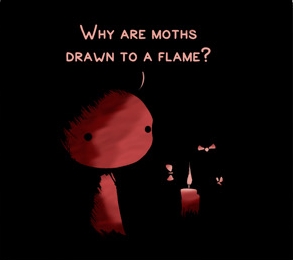Le falene, la fiamma, il senso della vita

“Thus hath the candle singd the moath.” (Shakespeare, The Merchant of Venice, 1596)
Il dubbio sul perché le falene (come molti altri insetti) siano attratte dalle fonti di luce loro prossime, spesso artificiali, non è ancora del tutto chiaro in ambito scientifico.
Alcune ipotesi, teorizzata la capacità delle falene (come di altri insetti) di orientarsi tramite la luce riflessa dalla luna assieme alle altre fonti luminose naturali anche di piccola entità, attribuirebbero la causa al fatto che questa verrebbe però a subire interferenze da parte di sorgenti “artificiali”, che essendo loro più vicine, ne distorcono la percezione, un po’ come un falso faro per una nave (vedi Wikipedia, qui sotto, o anche questa breve spiegazione).
Moths frequently appear to circle artificial lights, although the reason for this behavior remains unknown. One hypothesis advanced to explain this behavior is that moths use a technique of celestial navigation called transverse orientation. By maintaining a constant angular relationship to a bright celestial light, such as the Moon, they can fly in a straight line. Celestial objects are so far away, that even after travelling great distances, the change in angle between the moth and the light source is negligible; further, the moon will always be in the upper part of the visual field or on the horizon. When a moth encounters a much closer artificial light and uses it for navigation, the angle changes noticeably after only a short distance, in addition to being often below the horizon. The moth instinctively attempts to correct by turning toward the light, causing airborne moths to come plummeting downwards, and resulting in a spiral flight path that gets closer and closer to the light source.It has been suggested that the reason for moths circling lights may have to do with a visual distortion called a Mach band. The theory says that in the pursuit of cover and safety, moths fly towards the dark areas of the sky and are thus inclined to circle ambient objects in the Mach band region. The celestial navigation theory should cause moths to circle lights, not to head directly toward them, as many are seen to do. Mach conjectures that moths, which are nocturnal creatures, must find a place to hide from predators when daylight comes, but cannot do so in darkness. Their instinct when morning comes is to fly toward the light (presumably up) and then down again, with some probability of landing on a surface which matches their camouflage.
E ciò spiegherebbe anche il movimento a spirale, che dipenderebbe dalle traiettorie definite dalla menzionata teoria delle bande di Mach.
Ma questo non sarebbe di completa utilità per capire come tutte queste fonti, soprattutto le candele e ogni altra fiamma, creino questi scompensi, dato che le falene sono sensibili al calore e saprebbero per questo distinguere una sorgente capace di bruciarle dalla luna o altri riferimenti luminosi.
La teoria ulteriore, specialmente riferita agli esemplari di sesso maschile, come riporta sempre Wikipedia, vedrebbe coinvolto lo spettro infrarosso e la distorsione che esso può indurre nell’identificazione dei feromoni prodotti dalle femmine delle falene o dalla piante che cercano di favorire l'impollinazione grazie al trasporto inconsapevole di pollini da parte di questo animale.
A theory which has been advanced in an attempt to explain the attraction male moths have for candles specifically is based on olfaction. There is evidence that olfaction might be, in some cases, mediated by detection of the infra-red spectra of substances. The spiky infrared spectra of a candle flame happens to contain a number of emission lines which coincide with the vibrational frequencies of the female moth’s pheromone. The male moth is thereby powerfully attracted to the flame. Other sources with different spike patterns, e.g. hurricane lamps, are less powerful attractants.
via Buttersafe.com
In realtà, ecco la spiegazione reale, che si può trovare qui.
[spoiler]Scusate lo scherzone, ma da lì è iniziata l’idea di questo breve articolo :D [/spoiler]

